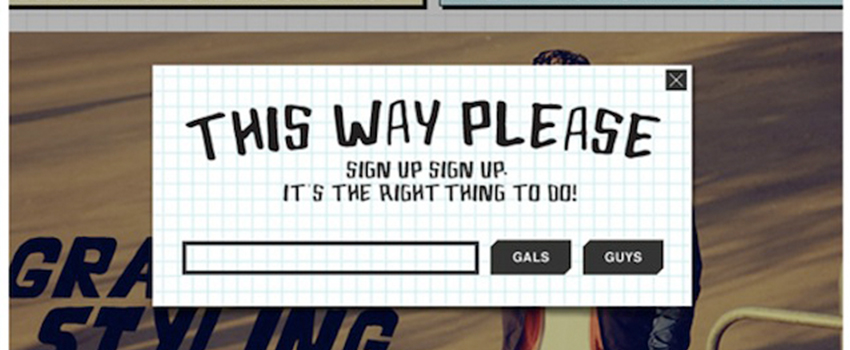The word is, pop-up ads are almost universally hated. In the Asia-Pacific region specifically, HubSpot found that pop-ups are one of the three most disliked forms of advertising, along with telemarketing calls and auto-play videos.
The IAB Ireland is warning advertisers to minimize their use of pop-up ads, because they’re so annoying that they are most likely to drive consumers to install ad-blocking software. In the United States, according to Alanna Gombert, deputy GM of the IAB Tech Lab and VP of Technology and Ad Operations for the IAB, their use is being evaluated by the Flex Ad Standards Working Group, which plans to release new recommendations later in the year.
Despite the hating, use of pop-up ads and their more diabolical cousin, hover ads, seems to be growing. That’s because when used well, they can increase conversions of all kinds. In this article, I’ll examine what marketing goals can be achieved using pop-ups, examine conversion rates and take a look at some of the best and worst practices.
Popping and Hovering
We should note that the terms pop-up and hover ad seem to be used interchangeably. They are different. The IAB defines pop-ups as, “Any advertising experience where visiting a website in an initial browser window initiates a secondary browser window to deliver an ad impression directly above the initial browser window.”
Hover ads, according to Wikipedia, are created using HTML5, JavaScript or other browser technologies to create rectangular ads that don’t move when you scroll the page. They just sit there, often blocking the content you wanted; plus, ad-blockers don’t block them. (That’s why I called them diabolical.)
Based on my web-surfing experience, at least 90 percent of what we call pop-ups are actually hover ads. Still, I’m going to go with the more common terminology and continue to speak of pop-ups.
Annoyance vs. Conversion: A Tradeoff
The question of whether using pop-ups is more likely to build your audience or turn it off has a lot of nuances. Last year, Google stopped delivering mobile pop-up ads that urged users to install its Google+ app.
Its analysis found that 9 percent of people who saw a mobile interstitial, which acts as a pop-up by blocking content, pressed “get the app.” Googlealso found that 69 percent of visitors neither installed the app nor continued to the mobile page. Instead, they just bounced.
Many app providers would be happy with a 9 percent CTR, right? Of course, this is a very specific case of a company trying to get users to switch from the mobile website to the mobile app. Even after install, the company would still need to get people to use the app – and then convert them within the app.
Google has many ways to profit from usage of its services: ads, referrals, and data. So it makes sense that the company found reducing bounces more important than driving app installs. If your business model requires you to acquire leads or customers, pop-ups can be your friend. By playing nice with this ad unit, you can make friends of consumers and not enemies.
Pop-up Goals
This much-maligned ad unit can accomplish some important goals:
Email newsletter sign-ups: So many websites these days use a pop-up to invite visitors to sign up for newsletters. We use them on Link-Assistant.com to invite people to subscribe to our blog, and we’ve found that each of our popups garners around 168 leads per month. (We’ll talk more about how we use pop-ups in the next section.)
Content downloads: This variation offers visitors a free report, e-book or other content; visitors need to provide an email address in order to download.
Discount coupons: To sweeten the site registration offer, even more retailers may offer an instant discount to those who purchase during that visit.
How to Keep From Popping Off Your Visitors
Pop-up ads don’t have to be that intrusive. Used well, they can provide a bit of extra encouragement for a visitor to engage with your company. We think this ad unit has gotten a bad rap among consumers due to the worst practices employed by many sites.
With more thought and some technology tweaks, it’s simple to up the results of a pop-up campaign without annoying consumers.
Worst Practice: The Roadblock
When new visitors come to your site via a link, direct navigation, or a search result, they’re interested in what you have to offer. But delivering a pop-up before they’ve had a chance to check out your wares might not be the best practice. This is particularly true when a popup requires some immediate decision, e.g. providing an email address to apply a discount right away.
Best Practices
There’s no clear research on exactly how long you should wait to ask for an email address. When AppSumo analyzed sites that used its List Builder software, it found that showing a pop-up after five seconds onsite was by far the most effective at gathering emails; the next most effective was after 20 seconds.
At LinkAssistant’s official blog, we show a pop-up offer to sign up for our newsletter after a person has spent 90 seconds on an article. You should test different delay times to see what works best for your site.
You can also configure the pop-up software to trigger when the visitor’s cursor moves up toward the back bar, indicating he’s about to leave.
Another option is being more polite with your pop-up and not covering up all the content. Search Engine Journal, for example, promoted a webinar with a pop-up box appearing aside an article.
The box appears when a reader has scrolled below the fold. It hovers until closed, but visitors can continue to scroll through the article without having to click on the X to close the box:
Worst Practice: Irrelevant Offer
Remember those spammy pop-up ads that would linger on your computer screen even after you’d closed your browser? This practice has mostly withered away, as advertisers of all types understand the importance of delivering relevant ads.
Best Practice
The delivery of third-party pop-up ads as a revenue generator can still be effective. The key is to use contextual targeting to make an offer the visitor is more likely to consider. For example, PCmag.com showed an ad for a book scanner over an article about the Kindle Oasis reader.
Those who enjoy reading books digitally presumably might be more inclined to want to move their physical titles over to the e-reader via a scanner.
Worst Practice: Box That Won’t Close
The most infuriating pop-up of all has to be the one that is difficult to close or cannot be closed at all. Sometimes the ad designer deliberately makes the X or “close” difficult to see to gain viewing time for the ad. In other cases, a coding error places the X out of the user’s visual field. This is especially a problem on mobile devices, where it can be difficult to cater to the huge diversity in screen sizes. When users are faced with an obscuring pop-up that can’t be closed, they have no choice but to bounce.
Best Practice
Many sites now use large “yes” and “no” buttons on their popups. Many sites make the choice explicit: For example, do you want to download a free product or continue reading what you’d clicked on?
For example, one of CRO optimization blogs offers a free e-book in return for e-mail sign-ups; the alternative is clicking, “No, I prefer to suck at optimization.”
Some people find this amusing; others would say it’s more on the passive/aggressive spectrum. You should definitely make your pop-up copy engaging and clearly state the benefits of subscribing, downloading or whatever your goal is. We’ll let you decide how far to go – or, better yet, test!
Worst Practice: Too Frequent
No means no, even when it comes to email sign ups. Once a site visitor has clicked the X or “no” button, the decision has been made. Nagging, in the form of repeated pop-ups, won’t work. It’s your job to convert these naysayers in other ways.
Best Practice
Make multiple offers to entice your visitors to provide email, and feature sign-up forms prominently on your site. For example, at Link-Assistant.com, we feature two more opportunities for users to provide their email addresses – without blocking the page view.
Making it Work for You
Just as with any other form of advertising, it’s important to test your pop-up ads. You should regularly perform A/B testing with every aspect of the ad: design, color, copy, offer, placement, and timing.
You should also make sure your use of pop-ups fits with your overall marketing goals. If you write a blog to show yourself as a thought leader, the content marketing value coming with full-page views may be more important than gathering email addresses. If your site provides hot deals, you may find it works better to offer a discount or free shipping during the checkout process rather than upfront.
The ubiquitous, sometimes ugly, pop-up ad isn’t going away. In fact – ironically — many mainstream publications are now using them to ask site visitors to turn off their ad-blocking software. When used carefully, they can be a valuable tool in customer acquisition. Just play nice!
___
by Aleh Barysevich


